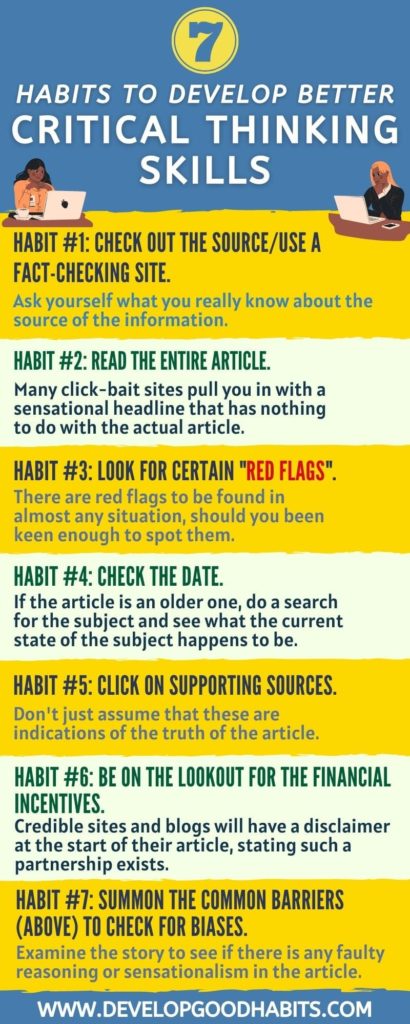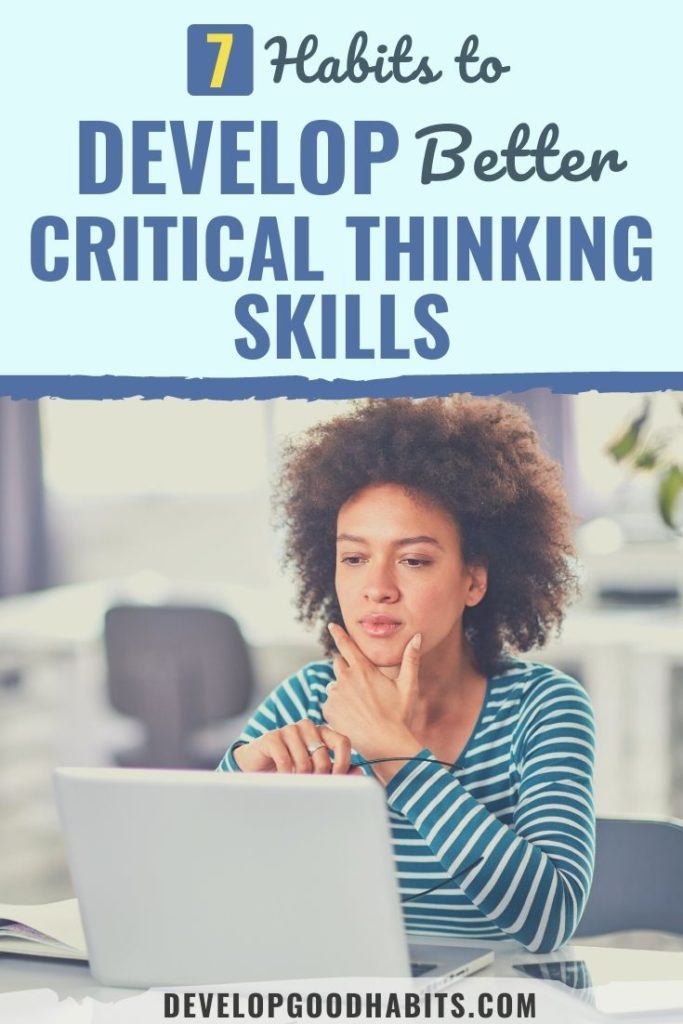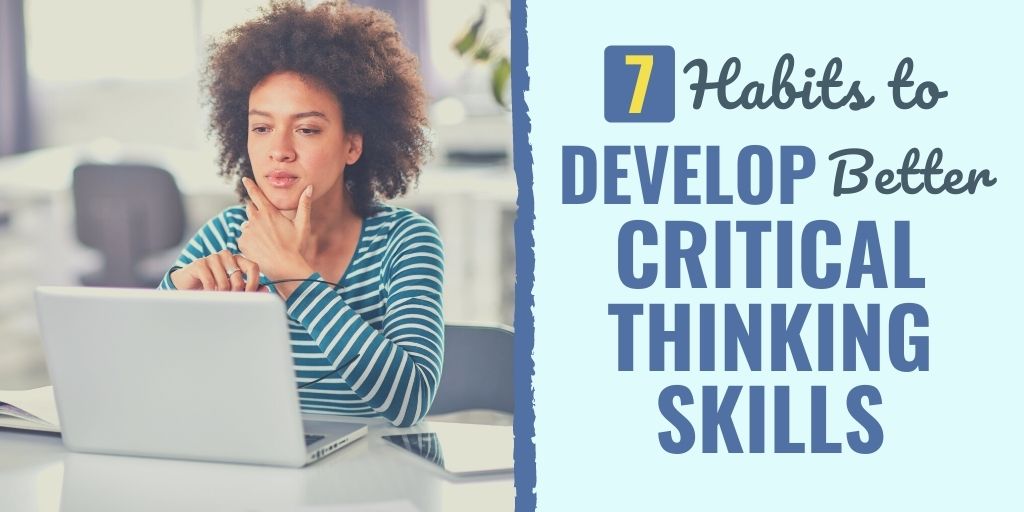Everywhere you turn these days you are bombarded with the thoughts and ideas of others. It used to be only those around you and television that you had to deal with… but, today, information and misinformation are everywhere.
You can't scroll through social media without seeing a multitude of “news” stories within minutes. The internet has made it possible for anyone to put up a website or blog and post what they call news… without anyone actually fact-checking.
Often, these stories are one-sided opinions created to get you to follow a cause or think in a certain way. Instead of relaxing, we often find our anxiety level rising by trying to discern what is true and what isn't. While it may seem like a lost cause, the good news is you can diffuse the situation by tapping into the way you process information.
By using critical thinking, you will be able to weed through this information easily. Unfortunately, schools don't often train us in how to develop critical thinking skills. At least, not in regards to determining which resources are accurate. So, let's take a look at how you can learn this all-important skill and eliminate some of the most anxiety-inducing false information you come across.
What Is Critical Thinking?
To put it simply, critical thinking is being able to examine information rationally and then be able to make a judgment that is based on rational examination. Critical thinking helps you avoid the trap of believing everything you hear.
If you are unable to use critical thinking, you are at the mercy of everyone and can be easily manipulated. In some cases, this can be as harmless as convincing you to buy a product that is useless. In other cases, it can be as horrible as following the lead of a dictator like Hitler. It may sound far-fetched, and you’re probably thinking “not me”… but it can happen. Spreading false information is how people like him get their sheep to flock; the only difference was the type of propaganda he used.
With the extensive role of social media in today’s society, it is essential that you learn how to develop critical thinking skills. Otherwise, you will never be sure about what is happening in the world and your emotions may end up in a constant uproar… which can and likely will result in physical issues.
Barriers to Critical Thinking
There are many barriers to critical thinking that we naturally develop over the years, most often starting way back in childhood. Here are some of the most common.
1. Consensus Thinking – This involves justifying the conclusion because a supposed authority says it is true or because a large majority of the population believes it to be so.
2. Argument Selectivity – This argument involves cherry-picking the facts so that only the ones that support your argument are given and the rest are ignored.
3. Circular Reasoning – You are using circular reasoning when the conclusion is used to support the argument even if there are few other reasons.
4. Cognitive Shortcut – This bias says that if two things happen at the same time, then one must have caused the other. It disregards any idea of coincidence.
5. False Analogy – This involves comparing two things even though they are only slightly related or not related at all. For this, think about comparing apples and oranges. They both may be fruit, but comparing them in other ways makes no sense.
6. Jumping to Conclusions – This is indicated by finding only a few facts and jumping to a conclusion without doing a more thorough search for additional facts that may change the outcome.
7. Overgeneralization – This is when you assume something is true in one case simply because it is true in another case.
These are just the most common types of what can get in the way of developing critical thinking skills. Cognitive biases are another common issue that can get in the way.
7 Habits to Develop Better Critical Thinking Skills
A fun way to start working on developing critical thinking skills is to learn to solve logic problems. These give you a way to practice finding the actual facts and can help you learn a bit about the person you are playing with.

These won't exactly tell you if a story or picture you see is true, but as your mind becomes used to the reasoning, the following steps will become easier. Let's take a look at how you can protect yourself from falling victim to false news on the internet.
Habit #1: Check out the source/Use a Fact-Checking Site.
Ask yourself what you really know about the source of the information. When you’re visiting a website, be sure to:
Habit #2: Read the entire article.
Ask yourself, does the content match the headline? Many click-bait sites pull you in with a sensational headline that has nothing to do with the actual article. If there are any quotes, try doing a Google search for the exact quote to see if it’s been published somewhere that is known to be reliable.
Also ask yourself, does the article acknowledge alternate viewpoints? Or does it attack a particular target? Good reporting doesn't generalize and isn’t bias.
Habit #3: Look for certain “red flags”.
Much like with our personal and professional relationships, there are red flags to be found in almost any situation, should you been keen enough to spot them. Here are some “red flags” that are often erected to disarm or distract you from your critical thinking skills.
Habit #4: Check the date.
Sometimes an article may be true at the time it was published, but there have been events or discoveries since that make it untrue. If the article is an older one, do a search for the subject and see what the current state of the subject happens to be.
This is often the case in such things as “unexplained lights in the sky” or events that are taken out of context. Medical knowledge and scientific information are constantly changing and growing. What was true ten years ago may not be what we now understand today.
Habit #5: Click on supporting sources.
Look for supporting sources in the article. Don't just assume that these are indications of the truth of the article. Look up the sources and examine their credibility. Whenever possible, trace any story back to the original source.
Do you remember that old whisper game we used to play as kids, called telephone? In almost every instance, the sentence or phrase changed by the time it made its way from the first person to the last? Any information can fall victim to misunderstanding or change from one source to another.
Habit #6: Be on the lookout for the financial incentives.
May websites and blogs will demonstrate bias in a very subtle way in order to get you to purchase a product, buy into an idea or visit another website, etc.… often for their own financial gain. It happens all of the time, so you’d be wise to frequently challenge an argument or viewpoint by looking at what incentive someone would receive if you follow their advice.
For instance, if a website is reviewing kayaks and offers their top three suggestions, check to see if these manufacturers or sellers are offering kickbacks for promoting their products. Credible sites and blogs will have a disclaimer at the start of their article, stating such a partnership exists. It may look something like this:
“There might be affiliate links on this page, which means we get a small commission of anything you buy. As an Amazon Associate we earn from qualifying purchases. Please do your own research before making any online purchase.”
As you can see, they are upfront about their compensation and encourage you to do your own research on the best products for you.
Habit #7: Summon the common barriers (above) to check for biases.
Examine the story to see if there is any faulty reasoning or sensationalism in the article. Ask yourself what the author's purpose for publishing this piece is. Over time, you will be able to see bias easily… but be sure you also take a look at your own biases.
Finally, check to see if the article elicits an exceptionally strong emotion. That is often an indicator of information being presented for a purpose other than simply relating news.

Now that you’ve armed yourself with useful habits to help you cultivate your critical thinking skills, we’ve got some additional tips for spotting fallacies.
Photographs and Search Engines
I would be remiss if we didn’t take a brief look at search engines, and how to tell if a photograph may have been manipulated.
Search engines are in business to make money and may present search results that are paid for by the highest bidder. When researching alternative sources for information, try doing so in a few different search engines to see if the top results are different or show a different angle to the information. Uncensored search engines such as DuckDuckGo and GIBIRU are two of the most reliable.
Photoshop can also work miracles with video and photographs. Recently there was a video of a man and woman singing the national anthem of Ukraine. It circulated the internet, stating that the couple was the President of Ukraine and his wife. In truth, it was a professional pianist and another woman. Yet people didn’t question it, but rather blindly clicked on “like” and “share”.
Here are some things you can do to check on the accuracy of a photo:
Think CRAPP
There is a method used to help you use critical thinking skills that is gaining popularity in colleges throughout the country. It is a test that you can apply to any piece of information, in order to see how well it passes the critical thinking issue.
C (Currency) – Is the information old and possibly outdated, or is it something that has historical value?
R (Relevance) – Does the information depth answer your question and meet the needs you currently have for answers?
A (Authority) – Is there enough information available on the author to let you know if they have proper credentials to write this piece? Is the author respected among their peers? Does the website have articles peer-reviewed?
A (Accuracy) – Is there enough detail in the article to help reach the conclusion of the piece? Can that information be backed up by reliable sources? What is the quality of the writing itself? Often, seeing spelling or grammatical errors alone should be a red flag that you need to look deeper before believing the information.
P (Purpose) – Ask yourself why the piece was created? Did the author write it to educate, inform, entertain, or persuade? Look for motivations that involve politics, commercial gain, or religion, and be willing to be skeptical until you verify accuracy.
Final Thoughts on How to Develop Critical Thinking Skills
Learning how to develop critical thinking skills is like building any other habit. It takes time and practice. It requires patience and self-reflection.
By executing these 7 habits and added tips regularly, you will eventually find yourself at a point where you’re doing it almost automatically… like second nature. It is an invaluable skill that can be taught at a young age, but often is not. That is why a person’s upbringing is often one of the barriers adults face when trying to developing this skill.
I’m a mom of four young children. If I’m being honest, I rarely if ever, encouraged my 3 and 4-year-olds to ask questions and understand things from different angles. Heck, most of the time it was just easier to simply tell them “this is how it is” and hope they accept it… so as to avoid arguments or tantrums (fingers crossed).
But take a cue from my mistake… trying to teach my children this valuable skill now (at ages 7-11), is not so easy. If you'd like to start teaching your kids how to develop critical thinking skills, don’t wait like I did. Check out our list of debate topics for kids to get the conversation going and their minds opening.


